土壤是固、液、气三相组成的松散颗粒集合体[1],气体与水分共同存在土壤孔隙中。土壤孔隙结构的性质包括结构与数量、大小分布、几何构型、连续性、连通性、弯曲度等形态数量特征、孔隙的空间分布及孔隙间相互连通状况,是土壤结构最值得关注的方面[2-3]。上述性质直接决定了土壤水分的供应与保持、气体交换与供氧能力[4]。土壤气体传输主要依赖大孔隙,其数量与比例决定土壤通气的能力[1]。土壤大孔隙的概念目前存在3种观点[5-7],由于研究者们的理解观点不同,导致对大孔隙孔径范围划分存在分歧,因此会根据实际研究需要划分孔隙大小[8-10]。孔隙连续性依靠孔隙通道的长度来反映,连通性是指孔隙间的连通状况[2]。土壤孔隙结构具有空间强变异性,土壤松散非固结性使得其研究存在诸多难点[3]。从早期的传统方法,到土壤切片[11]、CT扫描[12-13]、核磁共振[14]等技术的普及,土壤孔隙研究逐渐倾向于直接、定量的研究[15],目前研究重点在于模型方面,但这些模型均对土壤孔隙结构进行过简化,在实际应用中均不能实现对土壤孔隙结构的完全模拟。Ehler等[16]采用网络神经和波兹曼模型对毛孔结构进行研究,分析土壤水力特性与孔隙结构之间的关系。Moldrup等[17-18]提出了将空气传导性、气体扩散性和土壤水特征三者结合,评估土壤孔隙连通性的功能。此后,其他学者的研究评估了孔隙几何空间与贡献于水力传导的土壤孔隙两者的相互关系。Vervoort和Cattle[19]为研究毛孔空间几何弯曲程度和水力传导性的联系,对原状土土样的毛孔进行了图像分析。Tuli等[20]发现孔隙的大小分布对水力传导性和气体传输性函数关系的确定均起到关键作用。部分国内学者利用量化指数[21-22]及多重分形[23]的方法对土壤孔隙率展开相关研究。综上,前人应用土壤水力传导特征从宏观的角度来描述孔隙几何空间,提出了许多基于孔隙几何参数构建的特征分析模型[19-20, 24],但饱和导水率在田间土壤的变异性通常很大,且测量效率低下,往往需要更多的重复。原状土导气率高度依赖土壤孔隙结构[25-27],导气率的获取简单、快速、高效,且对土壤结构破坏小[28-29],利用土壤气体传输速率分析土壤结构、孔隙几何分布成为国内外学者关注的热点。关于分析原状土与扰动土因土壤结构改变造成孔隙几何特征发生变化的试验研究极少,故本研究分别测定了不同含水率、不同容重下的原状土与扰动土的导气率,基于此对土壤孔隙结构及弯曲连通性展开讨论,旨在为进一步揭示土壤气体传输的内在机制提供参考依据。
1 材料与方法 1.1 试验材料与设计室内扰动土试验开展于昆明理工大学现代农业工程学院土壤物理学实验室,室外原状土试验开展于昆明理工大学现代农业工程学院智能控制型温室东南侧空旷摞荒处。2016年4月初开展试验,试验土样经自然风干,碾磨过2 mm筛,使用马尔文激光颗粒分析仪测定土壤质地;采用国际制土壤质地分类标准,威尔克斯法测定田间持水量[30],结果如表 1所示。
|
|
表 1 土壤样本颗粒组成及质地分类 Table 1 Particle composition of tested soil and soil texture |
野外取土测定土壤容重,原状土采样位于土层15~25 cm处,在采样区域内随机取样,共计60个。为分析土壤含水率对导气率的影响,选取容重为1.3 g cm-3左右的原状土试样12个,室内试样制备取过筛且干燥后的试验土样,按容重1.3 g cm-3装入环刀内制作扰动土样本(尽可能接近1.3 g cm-3,最终以实际容重进行分析),共计12个;为分析土壤容重对导气率的影响,选取土壤含水率为200 g kg-1,不同容重水平(1.2、1.3、1.4、1.5 g cm-3)下的试样进行导气率分析,原状土选择容重接近初始设定水平的样本,扰动土按照初始设定水平进行装填,最终按实际容重计,每个处理设4个重复,共计32个样本(其中原状土16个,扰动土16个)。所有样本采集完毕用0.01 mol L-1 CaCl2溶液浸泡24 h,以稳定毛孔结构[20],并抑制潮湿环境下真菌等微生物滋生。
1.2 测试方法本研究采用PL-300型土壤空气传导性测量系统(德国Umwelt-Geräte-Technik GmbH公司)测定土壤导气率[31],采用环刀测量室,测量仪器示意图如图 1所示。
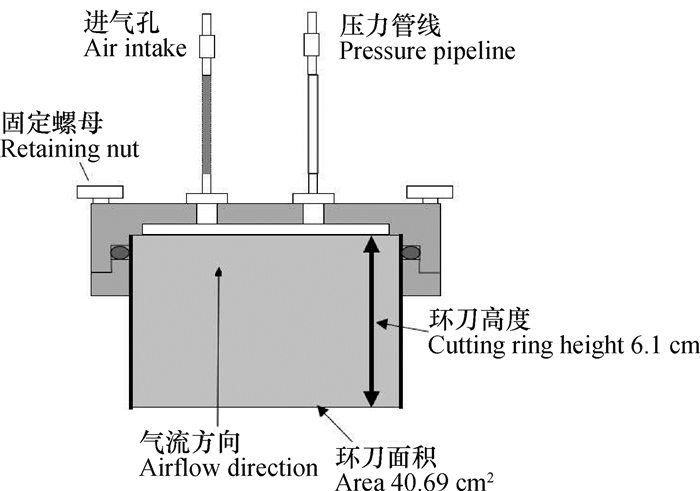
|
图 1 测量仪器示意图 Fig. 1 Schematic diagram of measuring instrument |
将供试土样饱和,静置至平衡,称重、测导气率;将试样连同环刀放入35℃烘箱中约6 h[20, 31],取出后静置,待其冷却至室温,称重并计算其含水率,测定此时的土壤导气率。重复以上步骤,依次测定含水率不断降低情况下的导气率,直至土样干燥;干燥法测容重。在测量过程中,土壤含水率不断减小引起土样轻微收缩,造成采样环内壁出现狭小的缝隙,导致漏气。因而在每次烘箱养护后、测量前使用石蜡进行边壁密封,防止气体沿边壁泄漏。为确保试验精确性,每组4个样本同时进行试验,取其平均值。
1.3 理论公式土壤水分特征曲线(Soil Water Characteristic Curve,SWC)能够反映土壤孔隙分布特征,Mualem[33]提出利用SWC曲线(Campbell模型[32])将弯曲连通系数作为固定值直接应用于相对导气率方程中分析气体传输特征。Tuli等[20]指出通过此种方法获取的弯曲连通系数对应的均方根误差较小,并提出利用描述相对导气率的方程确定孔隙弯曲连通程度的系数l值:
| $ {k_{ra}} = \frac{{{k_a}}}{{{k_{sa}}}} = {\left( {1 - {S_w}} \right)^l}{\left[ {\frac{{\int_{{S_w}}^1 {\frac{{d{S_w}}}{{{h_m}}}} }}{{\int_0^1 {\frac{{d{S_w}}}{{{h_m}}}} }}} \right]^2} $ | (1) |
式中,km为相对导气率;ka为导气率;ksa为饱和导气率;Sw为液相饱和度,l为孔隙弯曲连通性;hm为土壤基质势。
将式(1)变形积分,得:
| $ {k_{ra}} = \frac{{{k_a}}}{{{k_{sa}}}} = {\left( {1 - {S_w}} \right)^l}{\left[ {1 - S_w^{1 + \frac{1}{\lambda }}} \right]^2} = S_a^l{\left[ {1 - S_w^{1 + b}} \right]^2} $ | (2) |
式中,Sa为气相饱和度,Sa=1-Sw;λ表示孔隙大小分布的指标,λ=1/b;其中,b为土壤水分特征曲线对数关系图中斜率的绝对值。
式(2)两边取对数,可得:
| $ \ln \frac{{{k_{ra}}}}{{{{\left[ {1 - S_w^{1 + b}} \right]}^2}}} = l\ln {S_a} $ | (3) |
记
孔隙弯曲度的概念由Bear[34]于1972年提出,其表达式为式(4),孔隙弯曲连通性越好,τ值越大。
| $ \tau = S_a^l $ | (4) |
使用Excel2010进行数据处理,使用SPSS19.0比较数据模块单因素方差分析(ANOVA),其中P表示在相应F值下的概率值,F-crit表示在相应显著水平下的F临界值,通过P值判断组间的差异性,当F≥F-crit时,有显著差异。
2 结果 2.1 土壤含水率对导气率的影响含水率与容重是影响导气率的主成分因子[35],同时这两者亦是影响土壤孔隙含量与孔隙结构的主要因素,因而本研究中先分析含水率、容重对导气率的影响,进而展开基于土壤导气率对土壤结构与孔隙弯曲连通性的讨论。
为了得到土壤含水率对导气率的影响,选取容重为1.3 g cm-3的原状土与扰动土样本导气率实测数据进行分析,结果如图 2所示。由图 2知,导气率随含水率的增加而显著减小,且在含水率较低的情况下,导气率对含水率的变化较为敏感,标准差浮动范围较大。同一容重条件下,原状土导气率较扰动土导气率数值高,归因于土壤大孔隙的存在。水与空气一起占据了土壤孔隙,较小孔隙部分被水优先占据,较大孔隙则被空气优先占据[1],故土壤含水率的增加会造成孔隙度的减少,进一步降低土壤气体传输能力。
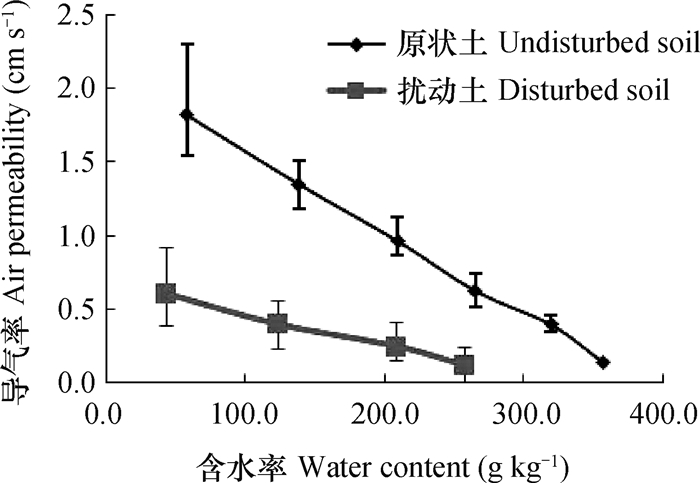
|
图 2 导气率与含水率的关系 Fig. 2 Relationship between air permeability values and water contents |
土壤空气更替通过相互连接的充气孔隙实现[1],土壤孔隙的大小、数量及结构共同确定了其通气性能。为分析土壤容重对导气率的影响,选取不同容重水平下土壤含水率为20%的原状土与扰动土试样进行分析。如图 3所示,土壤容重越大,其密实程度越高,孔隙结构受到压缩,孔隙度降低,导致土壤通气性能减弱,导气率下降。
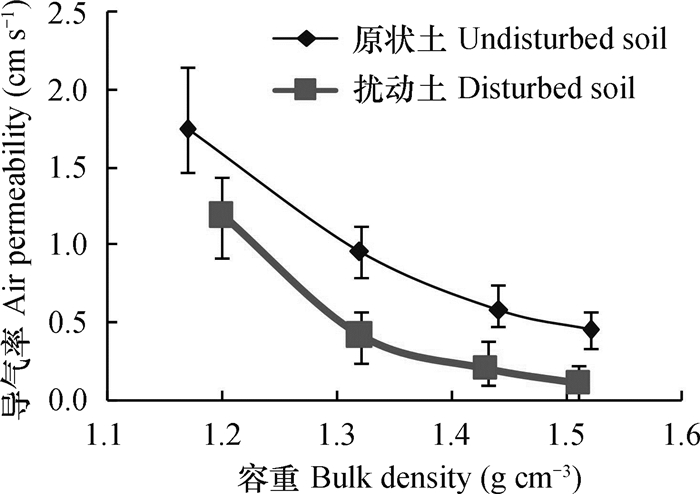
|
图 3 导气率与容重的关系 Fig. 3 Relationship between air permeability values and bulk densities |
由图 3得,原状土与扰动土的导气率随容重的增加而减小,当原状土容重为1.32、1.44、1.52 g cm-3时,导气率分别为1.17 g cm-3时的55%、33%、29%;扰动土容重为1.32、1.43、1.51 g cm-3时,导气率分别为1.2 g cm-3时的35%、17%、9%。
拟合导气率与容重之间的关系趋势线,原状土与扰动土样本均符合指数函数关系,如式(5)所示;原状土导气率数值略高于扰动土,且原状土导气率随容重增加而变化的曲线较扰动土平缓。扰动土的土壤孔隙结构受到较大程度的影响,其导气率较原状土均有不同程度的下降,归因于扰动土在处理过程中破坏了原有土壤结构,特别是对气体传输起关键作用的大孔隙。这与Tuli等[20]、王卫华等[31]关于原状土和扰动土与含水率关系的研究结果一致。
| $ \left\{ \begin{array}{l} 原壮土:\;\;y = 168.7{{\rm{e}}^{ - 3.91x}}\;\;\;\;{R^2} = 0.998\\ 扰动土:\;\;y = 9725{{\rm{e}}^{ - 7.54x}}\;\;\;\;{R^2} = 0.996 \end{array} \right. $ | (5) |
图 4为实测导气率与含气量之间的关系,含气量由样本充水孔隙(含水率)与样本总孔隙度计算而来(此处不考虑死孔穴的存在,认为孔隙均连通且被填充,非水即气[30])。在土样饱和时,此时气相连续性为零,则无法测量土壤导气率,视导气率数值为零,再次证明大孔隙对于气体传输的重要性。假设原状土与扰动土导气率曲线间隔距离由较扰动土样本增加的孔隙连通性而造成[30],从图 4中可以看出,原状土样本导气率与含气量之间的关系线条倾斜程度远大于扰动土,经显著性分析得F=6.366 942,P=0.020 202,F-crit=4.351 244,表明原状土样本孔隙弯曲连通性随气相饱和度增加而增加的程度较扰动土样本显著。
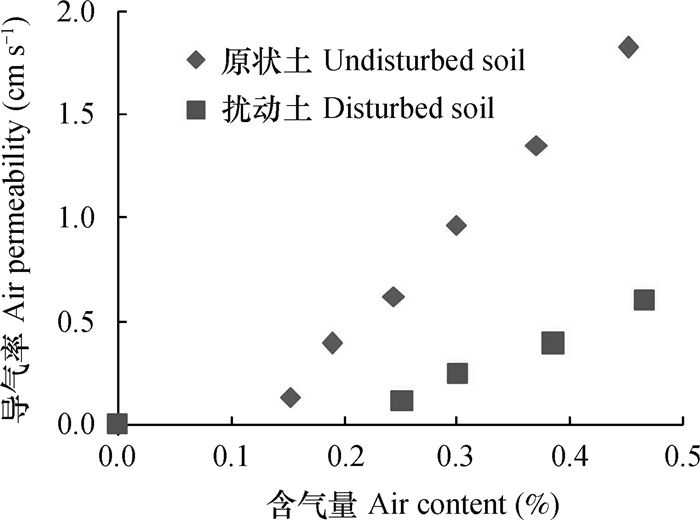
|
图 4 原状土、扰动土实测导气率与含气量的关系 Fig. 4 Relationship between measured permeability and air contents for undisturbed and disturbed soil samples |
上述分析可知,从导气率的绝对数值来看,扰动土明显小于原状土,主要归因于土壤结构的损坏,孔隙性状发生变动,导致大孔隙数量锐减。为了比较不同试样间导气率与含气量间的关系,为此采用相对概念进行分析,引入气相饱和度反映土壤孔隙状况,建立原状土、扰动土相对导气率与气相饱和度之间的关系,如图 5所示。量化的相对导气率数值与原状土、扰动土导气率实测数据具有相同的变化趋势,采用相对导气率剔除了由液相占据孔隙结构的影响。在样本接近饱和的情况下,气相孔隙连通度很低,致使气体传输速率维持在较低水平,在失水条件下,气相饱和度增高,土壤大孔隙结构贯通,气体传输速率显著增加,但气体传输的临界值(土壤干燥条件下的最大导气率数值)仍旧不明确。原状土与扰动土相对导气率与气相饱和度的关系曲线变化趋势基本相同,但不重合,证明即便在饱和度一样的条件下,两者的孔隙弯曲连通程度仍然有区别。
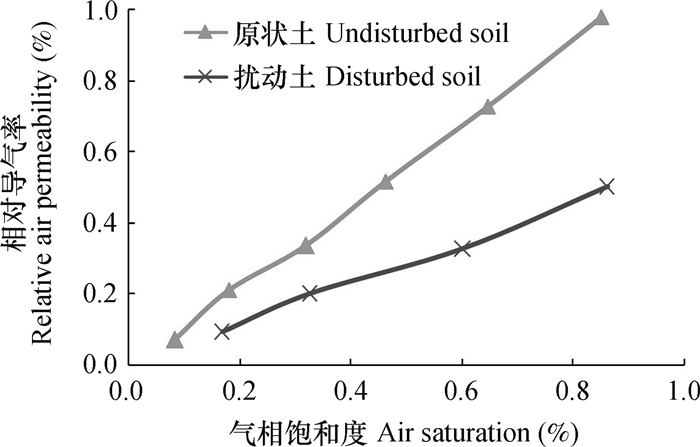
|
图 5 原状土、扰动土相对导气率与气相饱和度的关系 Fig. 5 Relationship between relative permeability and air saturation for undisturbed and disturbed soil samples |
图 4、图 5所示原状土与扰动土导气率的差异皆归因于土壤结构与大孔隙性状的改变,此观点由Blackwell等[36]于1990年首次提出。因此,建立气体模型必须考虑土壤样本间的孔隙结构变化[19],通过比较两者的相对导气率曲线来拟合孔隙弯曲连通系数是可以实现的。取原状土与扰动土样本导气率实测数据进行分析,根据Schaap和Leij[37]的建议,对弯曲连通系数进行修正,而非使用常数0.5作为弯曲连通系数的固定值。
首先建立对数关系的土壤水分特征曲线,如图 6所示。拟合线性关系趋势线,获得斜率的绝对值,即式(2)中的b值。以容重1.3 g cm-3的样本为例,按照式(3)步骤可得供试土样原状土与扰动土孔隙弯曲连通系数l分别为0.654、0.848(图 7)。同理计算可得其他容重供试样本的l值,进行描述性统计分析,结果列于表 2。
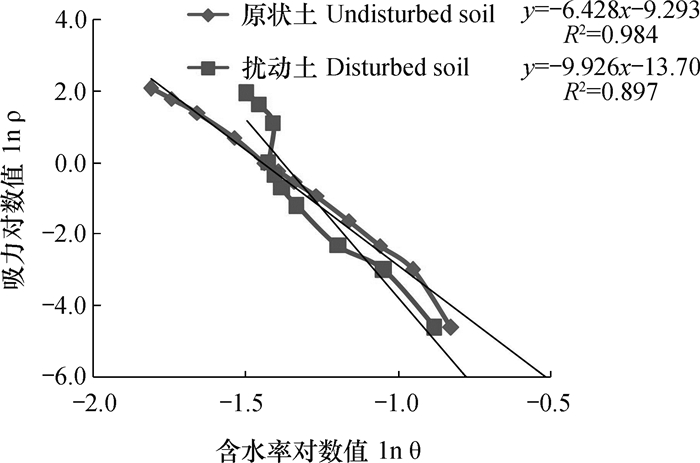
|
图 6 对数关系的土壤水分特征曲线 Fig. 6 Soil water characteristic curves in log-log relationship for undisturbed and disturbed soil samples |
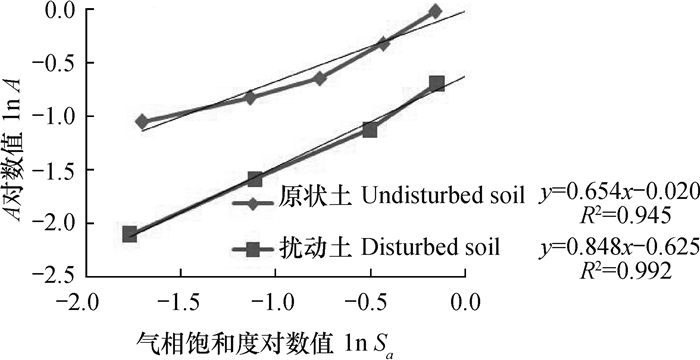
|
图 7 lnSa的关系图 Fig. 7 The relationship between lnA and lnSa |
|
|
表 2 孔隙弯曲连通系数描述性统计 Table 2 Descriptive statistics of soil pore tortuosity-connectivity parameters |
根据供试土样实测含水率推算气相饱和度,结合Tuli等[20]的推算经验,令孔隙弯曲连通系数l=0,0.5,1,…8,代入式(4)中,计算并绘制孔隙弯曲度τ与气相饱和度Sa关系图的基础构架,如图 8所示。将表 2中供试土样原状土与扰动土孔隙连通系数l的最大值、最小值代入式(4),经计算分别得到原状土与扰动土的孔隙弯曲度τ值,即图 8中的阴影部分的上下轮廓线,该阴影部分表示供试土样原状土与扰动土l的范围(非常数0.5),即相应气相饱和度下孔隙弯曲度τ值的取值区间。

|
图 8 原状土与扰动土孔隙弯曲程度与气相饱和度的关系 Fig. 8 Relationship between tortuosity and air saturation for undisturbed and disturbed soil samples 注:a.原状土,b.扰动土。阴影部分表示原状土与扰动土l的范围 Note:a. Undisturbed soil, b. Disturbed soil. Shaded areas represent the range of l parameters for undisturbed and disturbed soil |
拟合结果呈现:原状土与扰动土的弯曲连通系数值不同。扰动土的l值大于原状土的l值,但其导气率数值远小于原状土的。如图 8结果表明,l值代表气体传输时的孔隙弯曲连通效果,阴影部分呈现出扰动土与原状土样本孔隙弯曲度τ变化范围的差异;对于原状土与扰动土的τ值是不一致的,归结于大孔隙与土壤结构的作用导致原状土在高含水率下失去水分时的τ值突降,使得孔隙连通性显著提高,从而气体传输速率高。原状土导气率依赖于大孔隙的存在,扰动土导气率不仅依赖于孔隙连通的程度,还取决于孔隙弯曲程度,孔隙尺寸的分布亦是重要的影响因素,尤其是在接近饱和的高含水率情况下。此研究结论与Tuli等[20]研究结果一致(其指出在含水率接近饱和时,经过土壤大孔隙排水并达到气相饱和度阈值后建立气相连接),因此l值可作为土壤导气阈值的参考指标。
尽管弯曲连通系数作为拟合参数,与土壤物理基本性质等无特殊关系,但扰动影响土壤孔隙几何特性,在气体传输过程中,土壤颗粒及土壤孔隙的排列严重影响孔隙弯曲连通参数。应用数学模型对气体传输进行描述时,必须严格区分原状土与扰动土样本,充分考虑两者在孔隙分布上的差异[20, 31]。
3 结论原状土样本孔隙弯曲连通性随气相饱和度增加而增加的程度较扰动土样本显著;原状土与扰动土相对导气率与饱和度的关系曲线变化趋势基本一致,但并不重合,说明即使在饱和度相同的情况下,两者的孔隙弯曲连通程度仍然不同;原状土导气率主要依赖于大孔隙的存在,但扰动土导气率不仅依赖于孔隙连通的程度,还取决于孔隙弯曲度;原状土与扰动土弯曲连通系数的取值亦有较大差别;在高含水率条件下还应考虑孔隙尺寸分布对导气率的影响。在对土壤气体传输与孔隙结构进行相关研究并应用数学模型的过程中,除分析土壤物理基本参数以外,还应就原状土与扰动土不同的弯曲连通系数加以区分与讨论。
| [1] |
邵明安, 王全九, 黄明斌. 土壤物理学. 北京: 高等教育出版社, 2006. Shao M A, Wang Q J, Huang M B. Soil physics (In Chinese). Beijing: Higher Education Press, 2006. (  0) 0) |
| [2] |
孙经伟. 农业恢复措施对黑土母质发育的新成土土壤结构性质的影响. 北京: 中国农业科学院, 2015. Sun J W. The restorative effects of agricultural practices on soil structural properties of entisol newly developed from the parent material of Mollisol of China (In Chinese). Beijing: Chinese Academy of Agricultural Sciences, 2015. (  0) 0) |
| [3] |
程亚南, 刘建立, 张佳宝. 土壤孔隙结构定量化研究进展叨. 土壤通报, 2012, 43(4): 988-994. Cheng Y N, Liu J L, Zhang J B. Advance in the study on quantification of soil pore structure (In Chinese). Chinese Journal of Soil Science, 2012, 43(4): 988-994. (  0) 0) |
| [4] |
Baveye P. Comment on "soil structure and management: A review" by Bronick C J and Lal R . Geoderma, 2006, 134(1): 231-232.
(  0) 0) |
| [5] |
Beven K, Germann P. Macropores and water flow in soils . Water Resources Research, 1982, 18(5): 1311-1325. DOI:10.1029/WR018i005p01311
(  0) 0) |
| [6] |
Luxmoore R J. Micro-, meso-, and macroporosity of soil . Soil Science Society of America Journal, 1981, 45(3): 671-672. DOI:10.2136/sssaj1981.03615995004500030051x
(  0) 0) |
| [7] |
Skopp J. Comment on"Micro-, meso-, and macroporosity of soil" . Soil Science Society of America Journal, 1981, 45(6): 1246-1246. DOI:10.2136/sssaj1981.03615995004500060052x
(  0) 0) |
| [8] |
Watson K W, Luxmoore R J. Estimating macroporosity in a forest watershed by use of a tension infiltrometer . Soil Science Society of America Journal, 1986, 50(3): 578-582. DOI:10.2136/sssaj1986.03615995005000030007x
(  0) 0) |
| [9] |
Luxmoore R J, Jardine P M, Wilson G V, et al. Physical and chemical controls of preferred path flow through a forested hillslope . Geoderma, 1990, 46(1/3): 139-154.
(  0) 0) |
| [10] |
Singh P, Kanwar R S, Thompson M L. Measurement and characterization of macropores by using AUTOCAD and automatic image analysis . Journal of Environmental Quality, 1991, 20(1): 289-294.
(  0) 0) |
| [11] |
贺秀斌, 唐克丽, 张成娥, 等. 农业生态与土地退化的土壤微形态研究. 土壤与环境, 2001, 10(3): 234-237. He X B, Tang K L, Zhang C E, et al. Soil micro morphological study on agro-ecology and land degradation (In Chinese). Soil and Environmental Sciences, 2001, 10(3): 234-237. (  0) 0) |
| [12] |
冯杰, 郝振纯. CT扫描确定土壤大孔隙分布. 水科学进展, 2002, 13(5): 611-617. Feng J, Hao Z C. Distribution of soil macropores characterized by CT (In Chinese). Advances in Water Science, 2002, 13(5): 611-617. (  0) 0) |
| [13] |
王金满, 郭凌俐, 白中科, 等. 基于CT分析露天煤矿复垦年限对土壤有效孔隙数量和孔隙度的影响. 农业工程学报, 2016, 32(12): 229-236. Wang J M, Guo L L, Bai Z K, et al. Effects of land reclamation time on soil pore number and porosity based on computed tomography(CT)images in opencast coal mine dump (In Chinese). Transactions of the Chinese Society of Agricultural Engineering, 2016, 32(12): 229-236. DOI:10.11975/j.issn.1002-6819.2016.12.033 (  0) 0) |
| [14] |
Mantle M D, Sederman A J, Gladden L F. Single-and two-phase flow in fixed-bed reactors: MRI flow visualisation and lattice-Boltzmann simulations . Chemical Engineering Science, 2001, 56(2): 523-529. DOI:10.1016/S0009-2509(00)00256-6
(  0) 0) |
| [15] |
周虎, 吕贻忠, 李保国. 土壤结构定量化研究进展. 土壤学报, 2009, 46(3): 501-506. Zhou H, Lü Y Z, Li B G. Advancement in the study on quantification of soil structure (In Chinese). Acta Pedologica Sinica, 2009, 46(3): 501-506. DOI:10.11766/trxb200710300318 (  0) 0) |
| [16] |
Ehlers W, Wendroth O, de Mol F. Characterizing pore organization by soil physical parameters//Soil structure: Its development and function . Boca Raton, Florida, USA: CRC, 1995, 257-275.
(  0) 0) |
| [17] |
Moldrup P, Olesen T, Komatsu T, et al. Tortuosity, diffusivity, and permeability in the soil liquid and gaseous phases . Soil Science Society of America Journal, 2001, 65(3): 613-623. DOI:10.2136/sssaj2001.653613x
(  0) 0) |
| [18] |
Moldrup P, Yoshikawa S, Olesen T, et al. Air permeability in undisturbed volcanic ash soils . Soil Science Society of America Journal, 2003, 67(1): 32-40. DOI:10.2136/sssaj2003.3200
(  0) 0) |
| [19] |
Vervoort R W, Cattle S R. Linking hydraulic conductivity and tortuosity parameters to pore space geometry and pore-size distribution . Journal of Hydrology, 2003, 272(1): 36-49.
(  0) 0) |
| [20] |
Tuli A, Hopmans J W, Rolston D E, et al. Comparison of air and water permeability between disturbed and undisturbed soils . Soil Science Society of America Journal, 2005, 69(5): 1361-1371. DOI:10.2136/sssaj2004.0332
(  0) 0) |
| [21] |
Huang M, Zettl J D, Barbour S L, et al. Characterizing the spatial variability of the hydraulic conductivity of reclamation soils using air permeability . Geoderma, 2016, 262: 285-293. DOI:10.1016/j.geoderma.2015.08.014
(  0) 0) |
| [22] |
张慧娟, 孙宇瑞, 林剑辉, 等. 不同粗糙度尺度下预测表层土壤孔隙率量化指数比较研究. 应用基础与工程科学学报, 2009, 17(1): 69-76. Zhang H J, Sun Y R, Lin J H, et al. Comparative study on predicting porosity by different roughness indices (In Chinese). Journal of Basic Science and Engineering, 2009, 17(1): 69-76. (  0) 0) |
| [23] |
管孝艳, 杨培岭, 吕烨. 基于多重分形理论的农田土壤特性空间变异性分析. 应用基础与工程科学学报, 2011, 19(5): 712-720. Guan X Y, Yang P L, Lü Y. Analysis on spatial variability of soil properties based on multifractal theory (In Chinese). Journal of Basic Science and Engineering, 2011, 19(5): 712-720. (  0) 0) |
| [24] |
Chen J, Hopmans J W, Grismer M E. Parameter estimation of two-fluid capillary pressure-saturation and permeability functions . Advances in Water Resources, 1999, 22(5): 479-493. DOI:10.1016/S0309-1708(98)00025-6
(  0) 0) |
| [25] |
McCarthy K P, Brown K W. Soil gas permeability as influenced by soil gas-filled porosity . Soil Science Society of America Journal, 1992, 56(4): 997-1003. DOI:10.2136/sssaj1992.03615995005600040001x
(  0) 0) |
| [26] |
王卫华, 王全九, 王铄. 土石混合介质导气率变化特征试验. 农业工程学报, 2012, 28(4): 82-88. Wang W H, Wang Q J, Wang S. Experimental research on change characteristics of soil air permeability in stony soil medium (In Chinese). Transactions of the Chinese Society of Agricultural Engineering, 2012, 28(4): 82-88. (  0) 0) |
| [27] |
朱敏, 张振华, 潘英华, 等. 土壤质地及容重和含水率对其导气率影响的实验研究. 干旱地区农业研究, 2013, 31(2): 116-121. Zhu M, Zhang Z H, Pan Y H, et al. Effects of soil texture, bulk density and moisture content on soil air permeability (In Chinese). Agricultural Research in the Arid Areas, 2013, 31(2): 116-121. (  0) 0) |
| [28] |
李陆生, 张振华, 潘英华, 等. 一种田间测算土壤导气率的瞬态模型. 土壤学报, 2012, 49(6): 1252-1256. Li L S, Zhang Z H, Pan Y H, et al. Transient-flow model for in-situ measuring of soil air permeability (In Chinese). Acta Pedologica Sinica, 2012, 49(6): 1252-1256. DOI:10.11766/trxb201112130491 (  0) 0) |
| [29] |
雷宏军, 胡世国, 潘红卫, 等. 加氧灌溉与土壤通气性研究进展. 土壤学报, 2017, 54(2): 297-308. Lei H J, Hu S G, Pan H W, et al. Advancement in research on soil aeration and oxygation (In Chinese). Acta Pedologica Sinica, 2017, 54(2): 297-308. (  0) 0) |
| [30] |
王卫华, 王全九, 李淑芹. 长武地区土壤导气率及其与导水率的关系. 农业工程学报, 2009, 25(11): 120-127. Wang W H, Wang Q J, Li S Q. Character of soil air permeability and its relationship with water conductivity in Changwu, loess region of China (In Chinese). Transactions of the Chinese Society of Agricultural Engineering, 2009, 25(11): 120-127. DOI:10.3969/j.issn.1002-6819.2009.11.022 (  0) 0) |
| [31] |
王卫华, 王全九, 樊军. 原状土与扰动土导气率, 导水率与含水率的关系. 农业工程学报, 2008, 24(8): 25-29. Wang W H, Wang Q J, Fan J. Relationship between air permeability, water conductivity and water content for undisturbed and disturbed soils (In Chinese). Transactions of the Chinese Society of Agricultural Engineering, 2008, 24(8): 25-29. (  0) 0) |
| [32] |
Campbell G S. A simple method for determining unsaturated conductivity from moisture retention data . Soil Science, 1974, 117(6): 311-314. DOI:10.1097/00010694-197406000-00001
(  0) 0) |
| [33] |
Mualem Y. A new model for predicting the hydraulic conductivity of unsaturated porous media . Water Resources Research, 1976, 12(3): 513-522. DOI:10.1029/WR012i003p00513
(  0) 0) |
| [34] |
Bear J. Dynamics of fluids in porous media . Courier Corporation, 2013.
(  0) 0) |
| [35] |
王卫华, 王全九, 张志鹏. 流域尺度土壤导气率空间分布特征与影响因素分析. 农业机械学报, 2014, 45(7): 118-124. Wang W H, Wang Q J, Zhang Z P. Basin scale spatial distribution of soil air permeability and analysis of its impact factors (In Chinese). Transactions of the Chinese Society for Agricultural Machinery, 2014, 45(7): 118-124. DOI:10.6041/j.issn.1000-1298.2014.07.019 (  0) 0) |
| [36] |
Blackwell P S, Ringrose‐Voase A J, Jayawardane N S, et al. The use of air‐filled porosity and intrinsic permeability to air to characterize structure of macropore space and saturated hydraulic conductivity of clay soils . Journal of Soil Science, 1990, 41(2): 215-228. DOI:10.1111/ejs.1990.41.issue-2
(  0) 0) |
| [37] |
Schaap M G, Leij F J. Improved prediction of unsaturated hydraulic conductivity with the Mualem-van Genuchten model . Soil Science Society of America Journal, 2000, 64(3): 843-851. DOI:10.2136/sssaj2000.643843x
(  0) 0) |
 2018, Vol. 55
2018, Vol. 55

